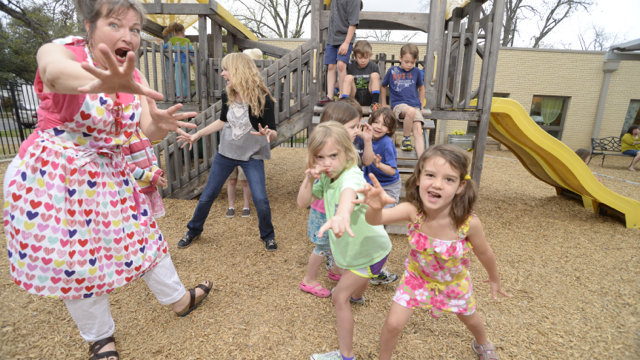Finding the right school for your child can be such a challenge. Sometimes the neighborhood public school just isn’t a successful fit for your child’s needs. Sometimes you’re not sure where to look for the ideal learning environment. Over 10 years ago, the AHB Community School was founded by a group of parents who sought something unique for Austin families. They wanted to create a creative and collaborative alternative school that fostered critical thinking skills and community engagement.
Today the AHB Community School is committed to helping you find the right fit for your student and your family. They offer a part-time (3-4 days/week), progressive education for children in the early years through middle years (grades K-8), located centrally in the Hyde Park area of Austin.
We recently had the chance to chat with Scott Tatum, the school’s Executive Director, to learn a little more about AHB Community School. Here’s what he had to say:
— What are the main elements that set AHB Community School apart from AISD or other local private schools?
AHB Community School stands apart from our peers in the public, charter, and private school market by being a singularly unique, non-profit independent school. It was founded by parents seeking a school that balanced critical thought and inquiry-based projects with whole-child and small community learning. These parents knew that with a small student to teacher ratio (9:1), a focus on hands-on learning, and a flexible part-time schedule, families could reap the benefits of formal instruction from highly qualified teachers while still spending significant time outside of the classroom exploring their relationships, interests, and world around them. All of this is done with a strong mind toward democratic practices (the school’s board of directors is primarily made up of the parents of students), cost efficiency that places our price point well within reach of most middle class families, and a passion for creating lifelong learners by igniting curiosity.
— Please tell us more about the teacher to student ratio and how faculty interacts with a mixed-age class.
AHB’s 9:1 student to teacher ratio and mixed aged classrooms puts into practice over a century worth of research into the best tenets of Progressive Education. The small, nimble effectiveness of strong, longitudinal relationships between 1 teacher and 9 students yields highly productive classroom sessions where teachers know well each student’s strengths and challenges, interests and passions and tailors instruction accordingly.
Having students in a multi-level classroom allows for high customization of the level each student is approaching the various skills and content areas by being able to provide a variety of level groupings. The sibling like relationship that occurs when slightly older students work with slightly younger students culls benefits by allowing for space for the younger students to reach beyond themselves and find success in areas they might not otherwise attempt and give older students opportunities to demonstrate mastery through synthesis and sharing of skills with their younger peers.
— Can you please tell us what a typical school day looks like?
There are few typical days at AHB. When students arrive for 9 a.m. start of classes, they meet with their peers and teachers to begin a day of working together to explore their inquiry-based projects. Sometimes this is a communication circle where they share thoughts about behavior or excitement about ideas. Sometimes this is a moment of reflection through meditation or yoga practices. From there, students and teachers embark on their activities and explorations for the day, moving through a variety of instructional practices (one-on-one, small group, peer, self-paced, teacher-led) to meet goals each student (with their family) have identified as priorities for learning in that quarter. All of these explorations are contained within a classroom created theme or inquiry point that allows the students and teachers to build up individual, group, and long-term projects.
— What kind of parental involvement is available at AHB Community School?
Parents are the bedrock of AHB’s model of Community School. Each family dedicates themselves to a service position throughout the year, becoming essential elements to the operation of the school. Parents who wish to serve on the Board of Directors for the school also have those opportunities each year. Beyond these formal opportunities, each parent is always welcome to be in the formal classroom at any time, whether reading stories to students, sharing professional experiences, skills, or interests, or being present at the many opportunities to share student work throughout the year. Parents also take on the role of teacher beyond the part-time formal classroom structure, modeling the ideas of lifelong learning by connecting experiences in the classroom to the world around them. As a school founded and governed by parents, their voices and ideas are absolutely valued and required for our continued existence.

— For families currently seeking the right school for their kids, is there anything else that you’d like to note about AHB Community School?
AHB Community School is like the City of Austin itself; we seek the balance of rigor and whole child education. We look for authentic opportunities to assess students such as portfolios and projects rather than standardized tests or letter-based grading systems. We value school and life balance knowing that education will always happen beyond the formal classroom and will always benefit from experiences in the world around us. We believe service, justice, and equity yields a more diverse, vibrant, and forward-thinking world. We are solution oriented, constantly seeking ways to improve our school and our community. We know students, even the youngest, have powerful voices and we recognize their agency in their own education. AHB Community School seeks to ignite and sustain a curiosity to better oneself through education that will carry them beyond our K-8th Grade classrooms and throughout their lives.
— More Info: You can find out more about the AHB Community School on their website, where you can learn more about the faculty, review the admissions process, and set up a school visit to check it out in person. You can also take a look at the school’s Facebook page to get a glimpse of the community spirit of the school.




